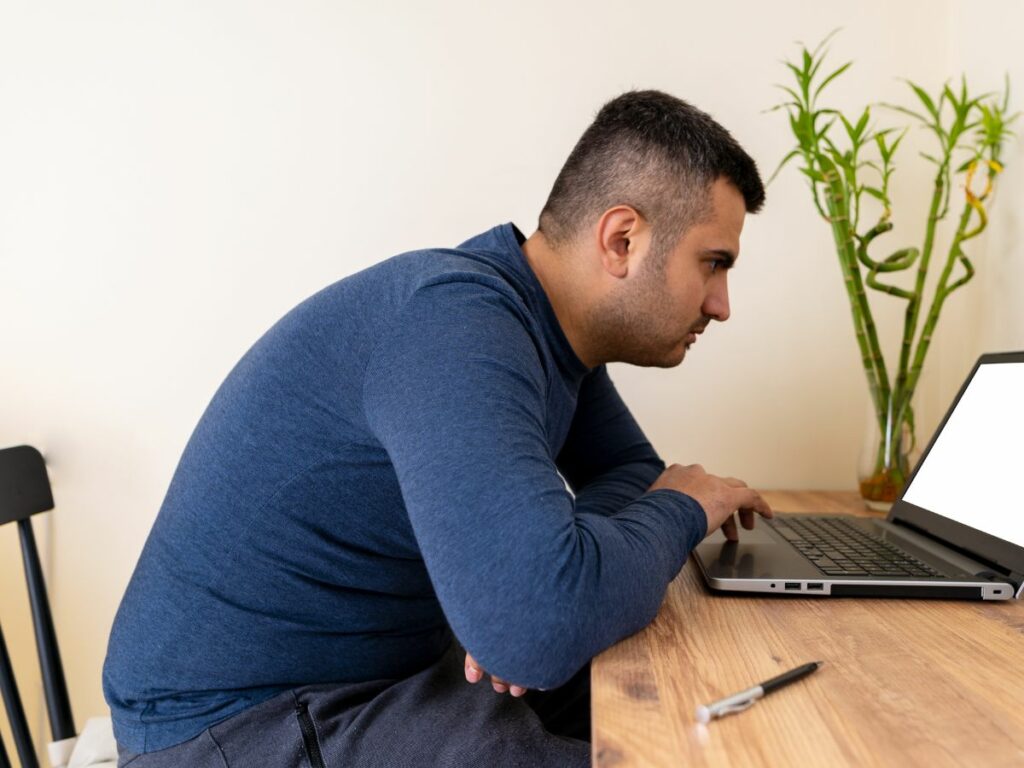

Why Does My Upper Back Hurt When I Wake Up?
A sore or stiff back when you wake up is often attributed to an improper sleeping form or an uncomfortable bed. However, if the pain lingers or comes back the next morning regardless of a stretch or even a bed change, there may be more to it.
When you can't link your upper back pain in the morning to something you did like a workout, finding its cause can be hard. Mornings need to be a reset and get you fresh and started for the day, so what do you do in this situation?
The deep ache between your shoulder blades or tightness near your neck is a sign your body is trying to tell you something. It can be the way you sleep, the stress you carry in your shoulders, or something deeper going on in your spine. Why does my upper back hurt when I wake up? Let's find out.
Waking Up with Upper Back Pain
Waking up with upper back pain makes your routine difficult like getting dressed, making breakfast, or even reaching for your coffee mug. You might think it’s something that will wear off with a bit of movement and sometimes that’s true.
Other times, it shows up again the next morning, and the day after that, turning into something more constant.
What It Might Mean
Your body resets itself while you sleep, but it can also hold onto things it didn’t fully release the day before. That stiffness you feel might not start during the night.
It can build up through small daily habits and only become noticeable after you’ve been still for hours. This discomfort doesn’t always mean something is seriously wrong.
It can signal that your muscles, joints or posture need more support or attention.
Why It Often Fades Away
Once you get moving, the pain sometimes starts to back off. Walking around, stretching a little or taking a warm shower may loosen things enough to make the discomfort fade.
That small improvement can be easy to ignore, but it holds an important clue. Movement encourages blood flow and activates muscles that have been locked in one position for too long.
If your pain improves as you become more active, it likely ties back to how you’ve been resting or holding tension.
- Your Sleeping Position
The way your body settles during sleep says a lot about how you’ll feel when you wake up. You may not even think twice about it, especially if it’s the position you’ve used for years.
But just because it feels comfortable in the moment doesn’t always mean it’s working in favor of your upper back. What happens at night can leave you stiff, sore, or misaligned by morning.
Sleeping on Your Stomach
Sleeping on your stomach can feel cozy, especially if you hug the pillow or bury your face into it. But this position often forces your neck to turn sharply to one side and keeps your spine at an awkward angle for hours.
That twist may not cause issues right away, but over time it can irritate your upper back and shoulders. Your ribcage and upper spine also get pressed in ways that limit natural movement.
This can lead to tension building up during the night, which shows up as soreness when you try to move again in the morning.

Sleeping on Your Side
Side sleeping usually feels like a safe, neutral option, and in many ways it can be. The issue starts when your shoulders bear too much weight or your upper arm pulls your shoulder forward.
That pressure can push your upper back out of alignment without you realizing it. When your head, neck and spine aren’t properly supported on your side, your muscles overwork trying to stabilize things.
Instead of resting, your upper back stays under tension all night, which can leave you waking up feeling stiff or achy near the shoulder blades or spine.

Sleeping on Your Back
Sleeping on your back gives your spine a better chance to rest in a natural position, especially when your pillow supports the curve of your neck instead of pushing your head forward. This alignment can take pressure off your upper back and help reduce the strain that builds during the night.
That said, back sleeping doesn’t guarantee relief. If your mattress sinks too much under your upper body or your pillow flattens over time, even this position can turn into a problem.

- Your Pillow or Mattress
Not all pain starts with your body. You may think your mattress feels fine or that your pillow has held up over the years, but what feels familiar isn’t always what’s best for your spine.
Upper back pain in the morning often has a lot to do with the surface you sleep on. Your neck, shoulders, and upper back all rely on proper support through the night.
Your Pillow
A pillow does more than cushion the head when sleeping. It also determines how your upper spine and neck align while you sleep.

If it’s too high or too flat, your head tilts forward or sideways in a way that strains the muscles around your shoulders and upper back. Waking up with a sore neck, tight shoulders, or pressure between the shoulder blades can be a sign that your pillow isn't holding the natural curve of your neck.
A pillow that supports the space between your head and mattress can reduce that tension and help keep your spine in better balance overnight.
Your Mattress
A mattress that sinks too much under your upper body throws everything out of line. Your shoulders might drop in too deep while your spine curves awkwardly, pulling on muscles that should be resting.
Even a mattress that once felt great can lose its support over time. Pain that shows up in the upper back but fades as the day goes on can point to a mattress that’s no longer holding your body evenly.
You don’t need something rock-hard, but you do need a surface that keeps your spine supported without letting your upper body sag.

What to Look For in a Better Sleep Setup
A proper sleep set-up doesn't need to be trendy or expensive. What matters most is that your setup fits your body.
- A pillow that matches your sleep position and shoulder width can make a big difference.
- A mattress that supports your spine without dipping too much under your upper back can ease the pressure that builds up overnight.
You can try folding a towel under your pillow for added height or placing a small cushion beneath your shoulder blades to see how your body reacts. Small adjustments can help you figure out what kind of support your body has been missing.
- Stress and Tension
You may lie down at night hoping for rest, but your body doesn't always get the message. Even when your mind quiets, your muscles can stay on high alert.
That tight, heavy feeling in your upper back may not come from your mattress or sleep position alone. It can come from stress your body never fully let go of the day before.
Emotional Stress Can Turn Into Physical Pain
When you're under stress, your body naturally reacts. Your shoulders rise without you noticing, your posture tightens, and your muscles brace as if something’s about to happen.
Even when you’re not in danger, your body treats tension like something it needs to fight or hold. That constant alert mode doesn’t always shut off at bedtime.
So even while you sleep, your muscles may stay partially activated. Over several nights, this can turn into soreness that greets you every morning like an unwanted habit.
Why Your Upper Back Holds Onto Tightness
The muscles around your spine and shoulders do a lot of lifting, both literally and emotionally. They help you stay upright, but they also carry more strain than you might realize. These areas are closely tied to your nervous system and are quick to respond to stress, posture changes or even shallow breathing.
Once tension takes hold in your upper back, it rarely disappears on its own. It needs active release through movement, deep breathing, or small physical changes during your day.
Ignoring it just gives it more time to settle in deeper.
- You’re Not Moving Enough
It’s easy to underestimate how still your body stays throughout the day. Between long hours at a desk, scrolling on the couch, or even driving, your upper back doesn’t get the motion it needs to stay loose.
The pain you feel in the morning can start with how little you move when you’re awake.
Too Much Sitting
Sitting isn’t the enemy by itself. It’s how long you do it and how little you change your position.
If your shoulders stay hunched or your head leans forward most of the day, your upper back stays slightly strained, even if you feel comfortable at the time. Once you lie down, your body is still again, but now it’s trying to recover from hours of stillness layered with stress.
This can leave your upper back sore in the morning, especially between the shoulder blades or near the base of your neck.

Daytime Stretches
You don’t need a full workout to support your upper back. A few minutes of targeted movement during the day can reset your posture and ease tension before it has a chance to settle in.
Shoulder rolls, wall stretches, and light backbends can open up the areas that get tight from sitting. Changes, like standing during calls or setting reminders to stretch once an hour, can prevent that buildup that turns into pain the next morning.
Your muscles are meant to shift, stretch, and support movement. When they stay in the same position for hours, especially with poor posture, tension builds.
- Common Underlying Conditions
Sometimes morning pain in your upper back isn’t caused by how you sleep or how often you move. It can come from something different.
When soreness sticks around no matter what changes you make, it may point to something your body has been trying to manage.
Mild Arthritis
Joint stiffness that fades after a warm shower or some light movement can be an early sign of arthritis. Inflammation around the spinal joints tends to increase overnight when the body is at rest, which explains why mornings feel worse than afternoons.
You might not feel sharp pain, but a dull, deep ache or grinding sensation in your upper back could signal early joint wear. This means your body may need more care and consistency to feel supported.
Herniated Discs or Spinal Issues
A herniated disc in the upper spine can show up as pressure, stiffness, or a sharp pinch between the shoulder blades. These symptoms often feel worse after lying still for several hours, which is why the pain shows up strongest in the morning.
Posture, age, or old injuries can all play a part in disc problems, and they don’t always cause issues right away. If stretching, sleep adjustments, and better movement habits don’t seem to help, it might be time to look at what’s happening in the deeper structure of your spine.

When to Talk to a Doctor
Pain that sticks around for more than a couple of weeks, especially if it’s getting worse or interfering with daily tasks, shouldn’t be ignored. Numbness, tingling, or pain that spreads into your arms could mean your nerves are involved, which calls for a closer look.
You don’t need to wait until things get unbearable. A quick visit to your doctor or physical therapist can help rule out more serious causes and give you a clearer picture of what’s going on.
Sometimes just knowing what you’re dealing with is enough to make better choices moving forward.
How to Relieve Upper Back Pain Between Shoulder Blades
Waking up with upper back pain can affect how you move, how you breathe, and how much energy you have left to give to the things that matter. This kind of discomfort doesn’t always have a single cause, and it doesn’t always go away with just one fix.
You may find that what’s bothering you most isn’t just the stiffness or soreness itself, but the pattern behind it. Pain between your shoulder blades, for example, often comes up as part of this same cycle.
It's one of the most common spots where stress and strain collect, especially if your posture or daily habits are off. Learning how to relieve that tension at night and throughout the day can determine your comfort when you sleep and wake up.
About Dr. Sean Ormond



